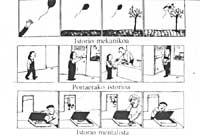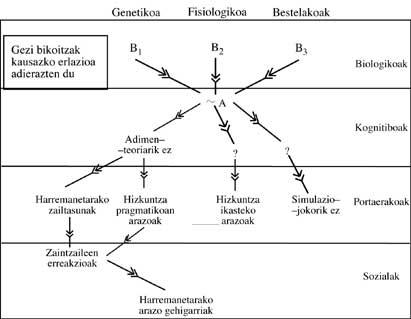The origin of autism

The movie Rain Man we saw a few months ago has awakened the attention that people can have on this disease. This term, which has often been taken as synonymous with introversion, means that a subject, breaking all his relationships with the environment, establishes his catexis (pulssional energies) in his inner world. Since the syndrome was discovered in 1943, discussions about its origin have been numerous. Recent evidence suggests that autism becomes a specific and specific deficit of knowledge. This deficit makes the autistic person unable to identify the thoughts and emotions of other people.
It is often said that autistic children treat people and objects in the same way, but sometimes they tend to retire completely, but sometimes they may have annoying, repetitive behavior. Their behavior is very typical: they want to be alone and live in a different world. Normally the environment and the outside world do not interest them. However, there are objects (technical or mechanical) that attract them very much and know how to use them with great skill.
They have communication problems both orally and in other behaviors. Children internalize the syntax and phonology of language, but learn more slowly other characteristics. They have special difficulties with the pragmatic problems of language. The metaphor of speech and other figures are very literal when it comes to understanding and using. For example, if an autistic child is called “Do you pass my salt?” he will surely answer us only “Yes” by pouring us a little and he will not understand the request we ask him with that question.
Although the three main symptoms of autism, the lack of capacity for social relation, communication and imaginative performance, at first appeared independent symptoms, nowadays it is believed that they constitute a true syndrome.
Some theories have taken as origin of autism one of these symptoms, the lack of capacity of social relation. It is well known the vision that takes as origin of autism the rupture of relations between the mother and the child. But this perspective leaves no room for the neurological or genetic characteristics of the child.
In the last ten years it has been quite clear that autism has biological origin. There are several reasons to say so:
In the first place, those born in certain medical conditions, such as suffering the rubella of the mother, tuberous sclerosis, or the chromosomal defect called fragile chromosome syndrome X, have greater propensity to suffer autism.

Second, autism is often accompanied often by mental retardation. Three out of four people with autism are delayed. On the contrary, the more late the child is, the more likely to be autistic. But that does not mean that only delay can cause autism, because many backward children have no symptoms of autism. Of all this we can conclude that the damage that can cause the delay can cause even autism.
In summary, Uta Frith (from the Cognitive Development Unit of the Medical Research Council) and the theory of its members argue that autists have a cognitive deficit by birth, that is, a deficit of some aspect of learning or reasoning. This deficit pushes children to inadequate development, thus creating the syndroma. To know what is the inadequate development we need to know some characteristics of normal development. It is important to know how the child internalizes the world, what kind of memo he creates, how he does it. Learning means being able to represent the facts and knowledge of the world, distinguishing between the first representations and metarrerepresentations.
In the simulation game, a two-year-old boy gets through a banana and recalls this game the next day. In other words, the child has in his memory a representation of the event. Ban ana is a metarrepresentation phone and banana is good edible should be kept separate from the sentence memory. The latter can be considered first representation. The difference between the first representations and the higher level representations lies in the possible inferences. If we add to the previous ones banana is fruit and orange is fruit, we can deduce that l. aranja is edible, but not orange is a phone. Presentations must be separated from other knowledge or from the other world.
According to Alan Leslie, of the Cognitive Development Unit, the characteristic of mental representation in the simulation game resembles “thinking”, “wanting”, etc., which are used in mental situations. The use of terms that express the mental situation, such as “believing” or “wanting”, is the expression of the ability to represent other people’s mental content.
To represent the desires (desires) of other people it is necessary to have interiorized some basic metarrerepresentations. The age of acquisition of skill is around the two years. It is more complicated to represent false beliefs of someone. For example, someone knows that his sister has kept the piece of chocolate in the box. When his mother finds chocolate, she puts him in the drawer. When his sister arrives, the child knows that “chocolate is in the drawer.” Her sister has the following representation: “Chocolate is in the drawer.” The child will receive the representation of his sister as a metarrepresentation; otherwise, he will fight with her. If the child is not able to create such metarrepresentations, his sister imagines that he knows where chocolate is. Studies conducted a few years ago showed that this type of metarrepresentation is not internalized by normal children up to four years.
As for autistic children, and based on Leslie's theory, Frith hypothesized that autists are not able to produce metarrepresentations. If this is true, terms such as “believing” are not able to properly understand and use or represent false convictions of other people. Leslie, Frith and others followed this hypothesis. The basic test was the representation by dolls. Lore, one of the dolls, has a marble. The canica is left in the basket and goes out. Ane, the other doll, takes the canica of the basket and puts it in the box. Lore returns and wants to play with the canica. Where will he look?

Although we know that the marble is not there, we know that Lore will look in the basket. That is, we can rethink what the real situation is and what the false belief of Lore is. Normal children can perform this test at approximately four years. Mongolian children can respond properly to six years. But in a group of 20 autistic children, with an average age of nine, 16 did not do well the test, despite being able to respond correctly to some questions about what was happening there. They knew where Lore left the marble, they knew that Ane moved and Lore did not see it. They had no memory or language problems. Autistic children could not conceptualize Lore's false conviction. This is the prediction of Frith and his companions based on the previous hypothesis.
With this prediction, how does the entire syndrome arise? Without these representations, autists are not able to create a “mental theory”. This means that they are not able to understand the desires, convictions and tendencies other people have (understand the desires, convictions and behaviors that lead them). Without this knowledge the social relationship has been totally limited. Our social relations are governed from the beginning by implicit rules. The normal child does not need to be in conditions (rewarded and punished) to learn social rules. These rules are part of the child's representation in relation to the mind of his parents, being independent his representation in the physical environment. The first representation of this type is a year ago.
The proposal is, therefore, that within autism there is a deficit of knowledge that leads to the lack of capacity to generate forms of representation. And what can we say about communication problems? When we speak of dialogue, most of what we say is based on the vision of other people. If we did not have this ability, we would have communication problems with autists.
This is the last question we could ask about this: How would this error explain the delay in the acquisition of the usual language in autism? In short, the acquisition of language consists of correctly categorizing phrases.
If the child calls the father saying, “Dad!” the father could answer “yes, I’m going,” “what do you want?” “what!” or something like that. It's not about what your father tells you exactly. It is about what the father means with those words, that is, if in that answer the words are one of the elements, besides the tone of the phrase, the gesture of the father, etc. are included. To know what kind of phrase you have been told, the child will have to take into account the humor and intention of his father. The autistic child will not be able to do it and for him it will be much more difficult.
Here we have outlined the chain from the inability to complete metal presentations to the main symptoms of autism. The origin of the problem is knowledge. This does not exclude the possibility of the biological base of autism. On the contrary, Frith and his colleagues believe that the lack of cognitive skill is not due to learning error or lack of motivation. It is an error of the machinery itself.
What links do we have in the source chain?

Frith has taken as origin of autism a cognitive deficit. The set of biological reasons can generate cognitive deficit. Although it is not able to specify these reasons, it is clear where they would be placed in the source chain.
We could say that autism is a biological deficit (a deficit that leads to development confusion) that occurs as the child grows and begins to relate to others.
What implications can this analysis have for therapy? Generally, the therapy tries to influence the initial factors of the chain. Since the cognitive deficit presented by autists can lead to secondary problems, such as the reaction of the parents and the emotional reactions after it, the therapy focused on the aforementioned factors can help.
In the development of autism the emotional problem can sometimes be the most serious aspect and many types of therapies can alleviate these aspects. In addition, therapists can help children learn the language. Because autistic children have not had enough individual teaching, they may have difficulties in this field.
But the metaphor of language and the difficulties of interpersonal relationship will only be cured with cognitive means. From the most pessimistic point of view, all autistic children lack a congenital ability that cannot be learned. The best therapy, therefore, can consist of systematically presenting the child a set of different social situations together with a normal resolution. The main idea of this therapy would be that children should learn an algorithm that allows them to predict what follows for each situation, even if they do not understand it. This is like learning that other people like “conversations”. The child may include a set of questions to use in certain circumstances, but not knowing exactly what the interviews are.
From a more optimistic point of view, autistic boys and girls have all the necessary structures, but within the brain they would have all without start-up.
From brain damage to social isolation
In the image we can see the chain on the origin of autism. The first elements are the pioneers who will leave the child with their specific biological deficits. These elements have been divided into the “genetic”, “physiological” and “other” sections. These pioneers generate a biological deficit called B 1 , B 2 , B 3. The presence of partial brain damage (e.g., biochemical deficit affecting a neurotransmitter or lack of connection between two parts of the brain) would be part of these deficits. All these deficits generate incompetence to complete the presentations, A.
~ ~ ~ ~ ~ ~ ~ ~ ~ ~ ~ ~ ~ ~
the sign indicates a lack of something. The absence of A generates problems of development (for example, problems of access to the language) and sometimes permanent deficit. In the image, it can also be observed that the child's abnormality can cause a reaction from others, which could cause additional relationship problems. In this way, environmental factors can come into contact with the biological and cognitive origin. In the image, elements of four areas appear as origin: biological, cognitive, behavioural and social. In the field of behaviour, the three main characteristics of autism are included.
If we discard the idea of biological base to complete the A, we would find ourselves in the need to invent new ties between the initial pioneer element and the absence of A. At the same time, if in this theory we exclude the cognitive aspect, we should form a chain between the biological base and the characteristics of behavior.
One of the small problems of the image is to leave aside the characteristics of motion and perception of autism. We should determine whether these characteristics come from cognitive deficits or whether they would start from a different biological base.






